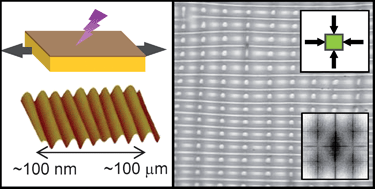We report a simple methodology to fabricate complex sub-micrometre periodic structures in poly(dimethylsiloxane) over large surface areas (several cm2). Single-frequency, uni- and multi-axial sinusoidal surface modulations, with tunable amplitude and wavelength, in the nano- to micrometre range, are readily demonstrated. The technique builds upon a buckling instability of a stiff layer supported by an elastomeric membrane (reported earlier), induced by surface oxidation of a pre-stretched elastomer coupon followed by removal of the applied mechanical strain. Plasma oxidation yields model surfaces with single wavelengths, sub-micrometre periodicity, achieving a dynamic range from sub-200 nm to 10s of µm, which UV ozonolysis extends to 100s of µm. We find that a single ‘dose’ parameter (exposure time × power) characterizes the surface conversion. The strain control provides unprecedented tunability of surface pattern amplitude and morphology, ranging from lines to complex periodic topologies induced under multi-axial deformation. We introduce a novel multiple strain–exposure and replication approach that extends surface topologies beyond lines, chevron and spinodal patterns (isotropic structures with a dominant wavelength). The resulting structures exhibit a glass-like surface, which is easily grafted with self-assembled monolayers to enhance functionality. Applications of this inexpensive and fast methodology include stamps for soft lithography, micromolding, templating and surface patterning.

You have access to this article
 Please wait while we load your content...
Something went wrong. Try again?
Please wait while we load your content...
Something went wrong. Try again?


 Please wait while we load your content...
Please wait while we load your content...